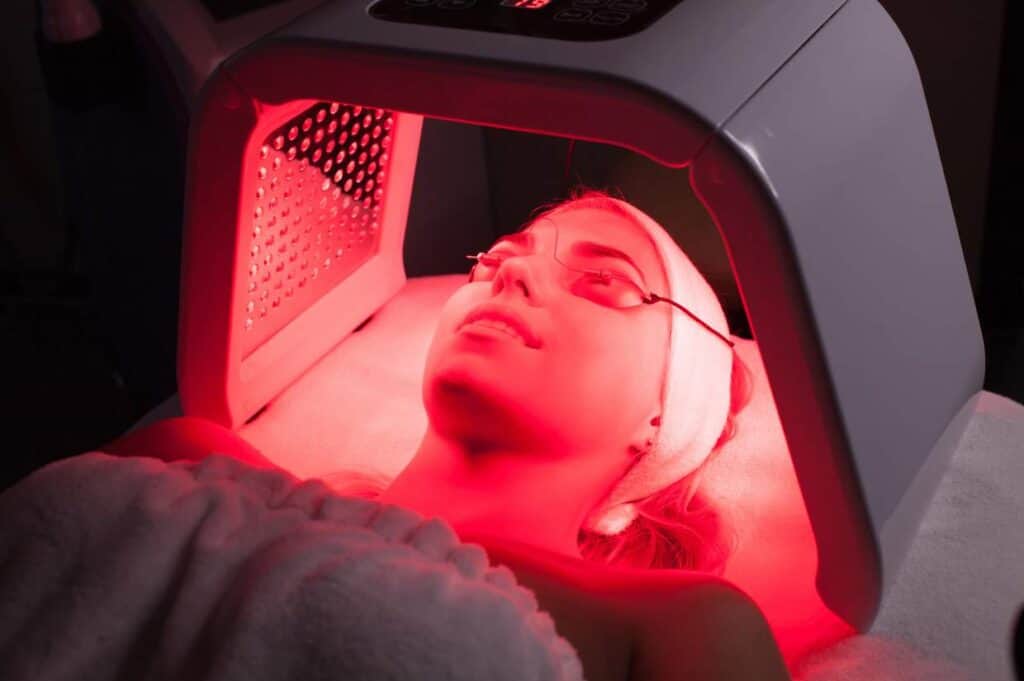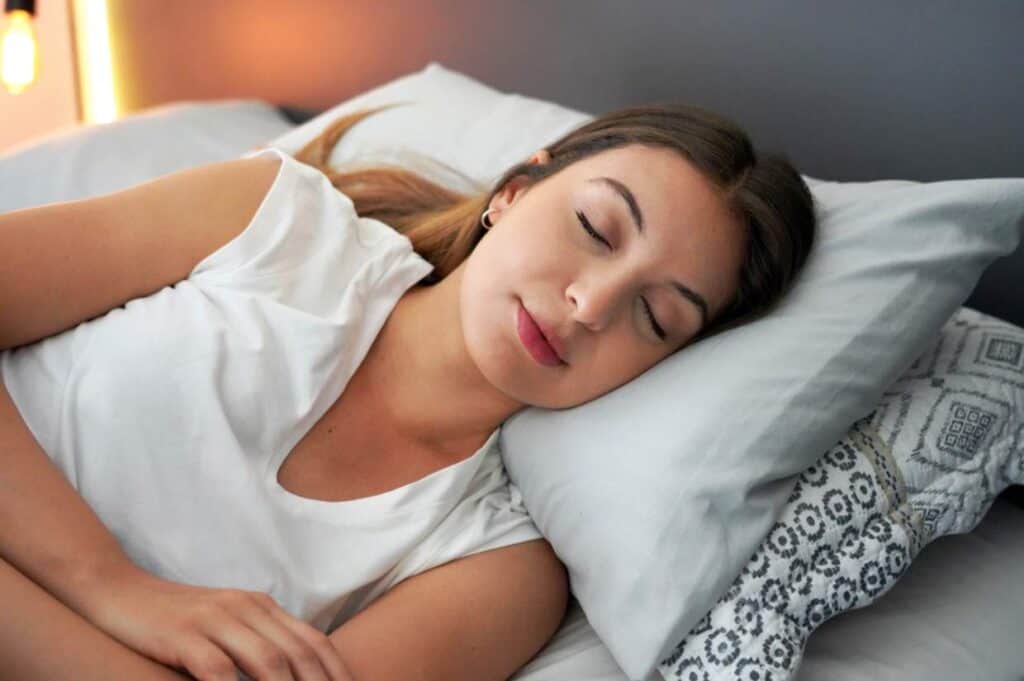What is red light therapy, and why should you add it to your skincare routine? Let’s talk about this trending skin treatment, how it can benefit you and some cool red light therapy facts you might not know about.

These statements have not been evaluated by the Food and Drug Administration. Please see the disclaimer below for more information.
Red light therapy has been around since the 1960s, but it wasn’t until recently that it became a popular treatment to reverse skin aging and collagen reduction. Today, you can buy your own red light therapy device and conduct sessions from the comfort of your own home.
When I first found out about red light therapy devices, the first thing that I noticed was how affordable they are compared to regular sessions at a spa or therapy center. Of course, I had to do my due diligence before jumping on the bandwagon and potentially saving thousands on my skincare routine. So, let’s take a look at what I found out about red light therapy.
Red light therapy can increase collagen density
Aging causes a natural reduction in collagen, which, in turn, makes the skin thinner, less voluminous and more prone to wrinkles. This is why a lot of anti-aging therapies and products today revolve around increasing collagen production or slowing down collagen loss.
There are plenty of ways you can increase your body’s collagen levels — or at least delay its loss as you age. You could try eating more foods high in collagen, such as bone broth, egg whites and organ meats. However, if you want something more intentional yet non-invasive, red light therapy can help.
A 2014 study by the Photomedicine and Laser Surgery journal found that near-infrared light or red light therapy may improve collagen density and reduce signs of aging. Researchers found that low-level light can boost the function of fibroblasts, which are responsible for collagen production in tissue repair, wound healing and dermal remodeling.

NASA originally developed red light therapy to promote plant growth during space expeditions
According to the National Aeronautics and Space Administration, red light therapy was originally studied and developed to grow plants in space. As they experimented with different light wavelengths, the researchers noticed that the abrasions on their hands exposed to the light healed faster than usual.
Thus, medical red light therapy was born. Fast forward a few decades, and red light therapy is now a widespread treatment for skin issues like aging, acne, stretch marks, sun damage and more.
“We bought Bioptron light therapy years ago and it completely transformed our lives. What began as a solution for my daughter’s skin issues turned into a versatile remedy for so many conditions.”
— Zuzana Paar, Sustainable Life Ideas
Skin rejuvenation results are temporary but can last up to a month
Like most non-invasive skin rejuvenation techniques, the results of red light therapy are temporary. A 2023 study published by the Journal of Skin Research & Technology found that photobiomodulation or red light therapy reversed the visible signs of aging in participants after two sessions a week for 3 months.
The results lasted for up to a month after using the red light mask. While temporary, the findings show that red light therapy can lead to lasting functional and structural skin rejuvenation.
You can use red light therapy to heal skin wounds
In a 2014 study, the Brazilian Society of Dermatology found that red light therapy can be an effective treatment for skin wounds. The researchers relate this benefit to red light therapy’s ability to reduce inflammatory cells, boost fibroblast proliferation and increase collagen production.
The American Society for Dermatologic Surgery also recommends red light therapy for sun-damaged skin, which is another factor in faster aging. Red light can increase adenosine triphosphate levels in the mitochondria which, in turn, can promote skin healing by increasing collagen, enzymes and healthy cell growth.

Red light therapy can help you relax and sleep better
While the main goal of red light therapy is to refresh and de-age the skin, many users report that it also helps them relax and get higher-quality sleep. In fact, a sleep experiment published by the Journal of Athletic Training revealed that red light can potentially increase sleep quality and prevent sleep disorders.
The Sleep Foundation also states that exposure to red light can help reset your circadian rhythm, which is your internal body clock that regulates the sleep-wake cycle. Your doctor may recommend red light therapy as part of your treatment of insomnia, circadian rhythm sleep disorders and other sleep issues.
I find red light therapy at home particularly relaxing, as red light has a calming effect as opposed to blue light’s stimulating effect. Even with short 10-minute sessions, I can feel my mind slowing down and my body relaxing into my bed or yoga mat. Meditation and listening to relaxing music also help, and I prefer to make my sessions screen-free.
“I’ve used red light therapy in combination with a PEMF mat and sauna for the last two years to help reset my nervous system while overcoming chronic Lyme disease. It’s hard to pinpoint modalities like this as they’re usually done in conjunction with many other changes, but I consider it to be a crucial part of my healing journey. If nothing else, it’s a relaxing time spent without technology where I can decompress for 20 minutes a day.”
— Gina Matsoukas, Running to the Kitchen
Light therapy may help ease depression
Many people who use red light therapy find that it’s a good method for natural stress relief, including me. However, the mood-boosting effects can go beyond just normal stress.
According to Harvard Health, red light therapy may help ease the symptoms of seasonal affective disorder or seasonal depression, major depression and even perinatal depression. Dr. Richard S. Schwartz, associate professor of psychiatry at Harvard Medical School, says that combining red light therapy and medications tends to be more effective than just using one treatment.
Although the mechanisms can vary, Dr. Schwartz cites that red light therapy can help regulate our circadian rhythm, which not only affects sleep but also digestion, hormones and other physiological functions. He also explains that red light can reach the prefrontal cortex, which is the part of the brain that regulates mood and cognition.
Red light may stimulate hair growth
Red light stimulation can also be an effective treatment for hair loss or alopecia, according to the Annals of Dermatology. Their study on androgenetic alopecia, a condition that causes hair thinning, shows that red light can promote hair growth and reverse its development.
This application of red light can be particularly helpful for people with alopecia and early onset hair loss, especially because hair loss medications are limited. It can also be a safer, non-invasive and less expensive alternative to hair transplant surgery.
Try red light therapy today
Red light therapy has a wide range of medical and cosmetic applications. If your doctor approves, it can be a worthwhile investment into your self-care routine.
Have you tried red light therapy before? What was the experience like for you? Share your thoughts in the comments below.
These statements have not been evaluated by the Food and Drug Administration. The contents of this article, made available via Food Drink Life, are for informational purposes only and do not constitute medical advice. The content presented here is not intended to be a substitute for professional medical advice, diagnosis or treatment. Always seek the advice of a qualified healthcare provider with any questions you may have regarding a medical condition or dietary changes. Reliance on any information provided by this article is solely at your own risk.
Jessica Haggard is dedicated to helping people cook easy everyday recipes focusing on bioavailable and nutrient-dense foods. She helps people overcome food allergies and discover healthy recipes that make a difference in their health with gluten-free, low-carb and keto cooking at Primal Edge Health.